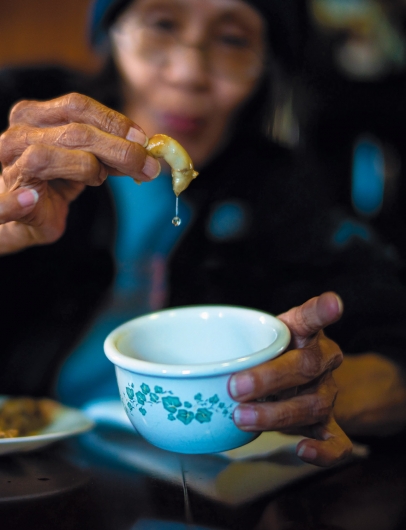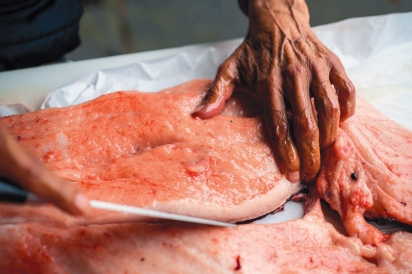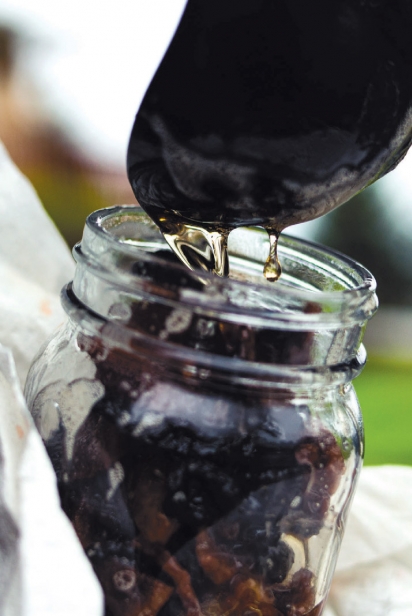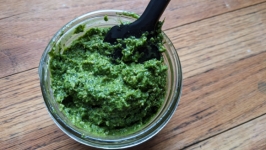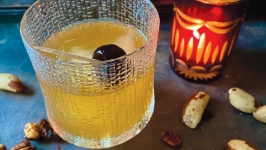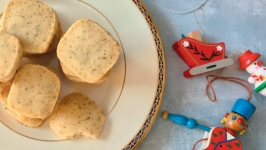A Taste of Home
Joni Elisoff’s Seal Grease
Joni Elisoff’s Tlingit name, Kaayistann, means “friendly person.” She embodies that title with each soft smile and every act of generosity. “Seal oil is best enjoyed with company,” she explains while cracking a jar of honey-colored, rendered seal blubber.
Seal oil, or “seal grease,” is surprisingly mild. “It tastes almost like olive oil,” says Elisoff. We drizzle it over a smorgasbord of oceanic offerings that she and I harvested—fresh abalone from the morning’s low tide, a thawed bag of herring eggs, smoked clams and cockles, and seaweed with salmon roe. The oil glistens, gliding over our intertidal snacks, elevating the richness of the flavors. She also enjoys it over gumboots, potatoes—just about anything.
“My mom and her girlfriends would get together and this is what we would do in the past. Everyone would bring something different and we would just have a big feed and all come together. That’s what my earliest memory of seal oil would be.”
Seal oil is versatile. Along with being used as a condiment for dipping or drizzling, it can be added to soups and stews for flavor, or used in Elisoff’s favorite snack—”trail mix.”
“You toss the seal oil with dry fish, either salmon or halibut, and let it drain through a cheesecloth. Then, you toss the dry fish with sundried black seaweed.” Trail mix is addicting, she says, but healthy. “If you think about it, you’ve got all the vitamins from your seaweed, all the nutrients from the fish and from the seal oil, and it’s a good light snack you can take out hunting or fishing!”
Seal oil has been an important source of calories, vitamins, and fatty acids for coastal communities for thousands of years. The Department of Environmental Conservation indicates that 3 ounces of seal meat provide 80 percent of our daily iron requirement. It would take 68 chicken nuggets to hit that mark. Seal oil, though not rich in iron, is dense in omega-3 fatty acids. Omega-3 fatty acids help decrease symptoms of diabetes, hypertension, cardiovascular disease, autoimmune diseases, arthritis, and more. The density of healthy fatty acids in seal oil far surpasses that of butter or vegetable oils. Elisoff consumes a tablespoon of seal grease just to warm her body.
“I look to my Native foods for health all of the time,” Elisoff says as she starts boiling some Hudson Bay tea to follow our meal. She explains how family and friends, especially outside of Alaska, distanced from traditional foods, may seek protein and happiness in fast foods or convenient meals that lack the nutrition and spiritual value of foods like seal oil and salmon eggs. “My Native foods have helped me manage my ailments and my cholesterol,” says Elisoff. “So I share them constantly with everyone I love.” She sends care packages to grandkids, daughters, siblings, and others in Fairbanks, Juneau, the Lower 48 and beyond who often beg for her famous seal oil in particular—a “taste of home.”
Marine mammals are federally protected by the Marine Mammal Protection Act. Seal hunting is permitted for Alaska Native hunters and managed by the National Marine Fisheries Service. Elisoff gets most of her seal blubber from friend Robert Miller, who harvests the seals for their hides to sew into hats and other products through his business, Sea Fur Sewing. He shares the meat with elders like Elisoff.
“My elders would just take the seal blubber and hang it so that over time, the oil would drip into a bucket. They don’t cook it, just let it drain. It is really strong that way, but once you get it past your nose, it is wow, really good.”
Elisoff prefers to render her oil, cooking the sliced and boiled blubber patiently over low heat. The flavor and mildness are altered by how the oil is cooked, which also impacts the shade and color. The darker the oil, the stronger the flavor. She likes all the shades, but she prefers it best when it is light and mild.
Once the seal has been carefully skinned, Elisoff boils slabs of blubber about the size of a book to pull out any remaining blood. The boiling blubber will create foam which you should skim off. She continues to boil the blubber until the foam stops. This process also slightly hardens the texture of the fat, making it easier to slice in the next step.
Elisoff then slices the blubber about one inch long and a little wider than thick cut bacon. She heats a pot over medium heat. As the blubber renders and crisps, it releases the oil. She pulls out pieces and reserves them on paper towels or in a bowl. Those blubber bits, or seal cracklings, can be enjoyed fresh with a little sprinkle of salt or can be drizzled with oil and reserved in jars for eating later.
Finally, she spoons the oil into jars or other containers. Seal oil must be processed carefully to minimize health risks like botulism. To reduce those risks, the DEC recommends cutting all seal meat off the blubber you intend to render. Then once the blubber is rendered, they suggest, boil the oil, pour it into sterilized airtight containers or jars, and freeze or refrigerate them. With both the oil and the cracklings, Elisoff keeps jars of them in the fridge if she plans to eat the products quickly. Otherwise, she preserves her bounty in the freezer. Though, most of her oil she shares.
“You need to cook it carefully and slowly over low heat, pulling out the pieces of blubber as they render, in waves.” Elisoff says that the secret ingredient of her seal oil is patience. That, a happy heart, and a generous spirit make it worthy of praise.


